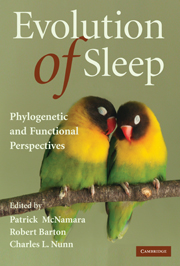Book contents
- Frontmatter
- Contents
- Contributors
- Acknowledgments
- Introduction
- 1 Ecological constraints on mammalian sleep architecture
- 2 Sleep in insects
- 3 Schooling by continuously active fishes: Clues to sleep's ultimate function
- 4 What exactly is it that sleeps? The evolution, regulation, and organization of an emergent network property
- 5 Evolutionary medicine of sleep disorders: Toward a science of sleep duration
- 6 Primate sleep in phylogenetic perspective
- 7 A bird's-eye view of the function of sleep
- 8 The evolution of wakefulness: From reptiles to mammals
- 9 The evolution of REM sleep
- 10 Toward an understanding of the function of sleep: New insights from mouse genetics
- 11 Fishing for sleep
- Index
- Plate section
- References
2 - Sleep in insects
Published online by Cambridge University Press: 10 March 2010
- Frontmatter
- Contents
- Contributors
- Acknowledgments
- Introduction
- 1 Ecological constraints on mammalian sleep architecture
- 2 Sleep in insects
- 3 Schooling by continuously active fishes: Clues to sleep's ultimate function
- 4 What exactly is it that sleeps? The evolution, regulation, and organization of an emergent network property
- 5 Evolutionary medicine of sleep disorders: Toward a science of sleep duration
- 6 Primate sleep in phylogenetic perspective
- 7 A bird's-eye view of the function of sleep
- 8 The evolution of wakefulness: From reptiles to mammals
- 9 The evolution of REM sleep
- 10 Toward an understanding of the function of sleep: New insights from mouse genetics
- 11 Fishing for sleep
- Index
- Plate section
- References
Summary
Fond as the butterflies are of the light and sun, they dearly love their beds. Like most fashionable people who do nothing, they stay there very late. But their unwillingness to get up in the morning is equalled by their desire to leave the world and its pleasures early and be asleep in good time. They are the first of all our creatures to seek repose.
The Naturalist on the Thames, C. J. Cornish, 1902, p. 44From these charming observations of insect quiescence made more than a century ago to current molecular and genetic studies in the fruit fly, the study of insect sleep during the last decade has evolved into a sophisticated field of inquiry for dissecting the potential cellular mechanisms controlling sleep in living organisms. The fundamental question of why we sleep continues to be unanswered, but it is likely that sleep in living organisms evolved from ancient origins (Allada & Siegel, 2008; Siegel, 2005). By examining insects, which have a long phylogenetic history, clues to the function and purpose of sleep may be discovered. Sleep in mammalian species such as humans, cats, and rodents has been well studied (Zeplin, Siegel, & Tobler, 2005). In contrast, there are relatively few systematic investigations of nonmammalian vertebrate sleep, and the literature is even sparser for invertebrate species. Insect sleep, with rare notable exceptions, is almost completely unstudied.
- Type
- Chapter
- Information
- Evolution of SleepPhylogenetic and Functional Perspectives, pp. 34 - 56Publisher: Cambridge University PressPrint publication year: 2009



